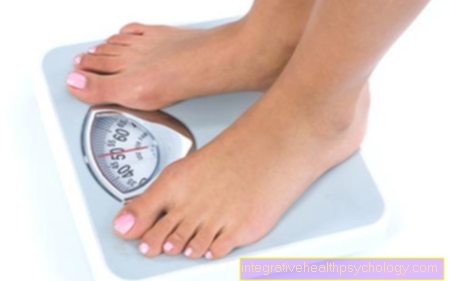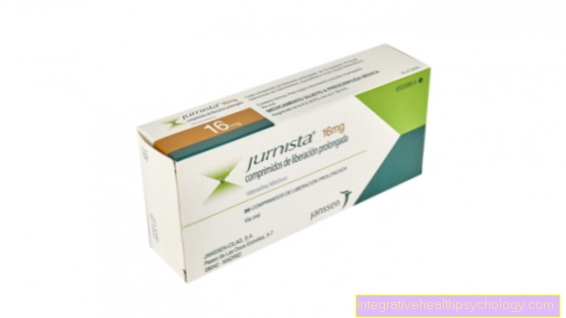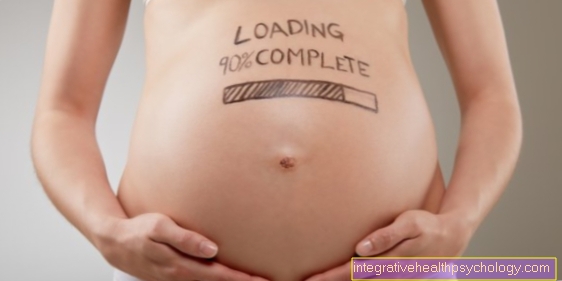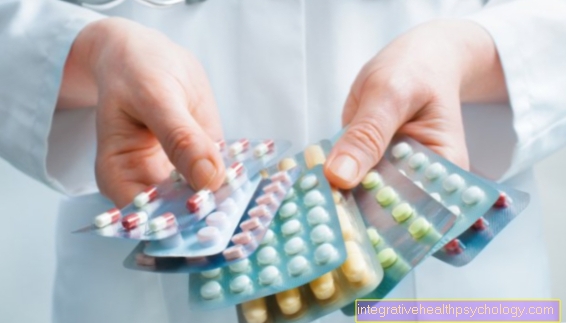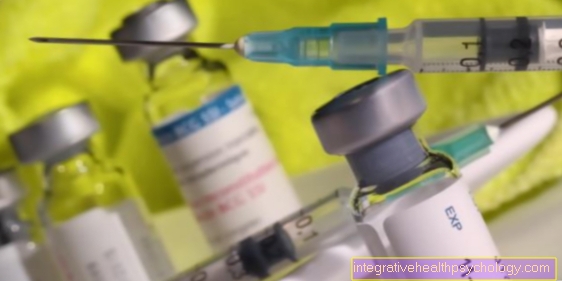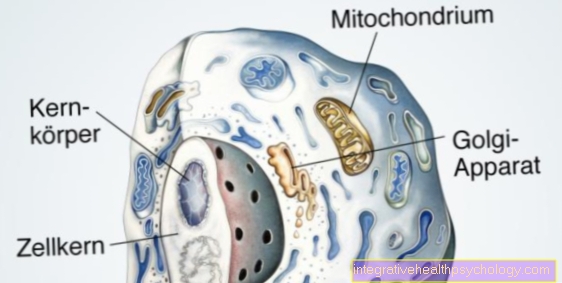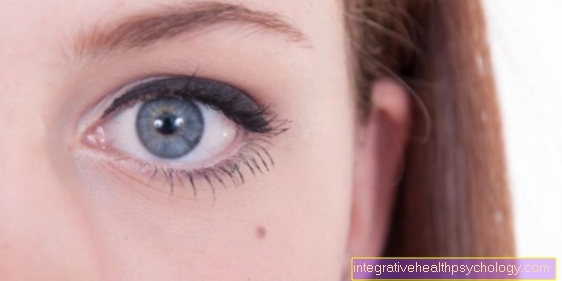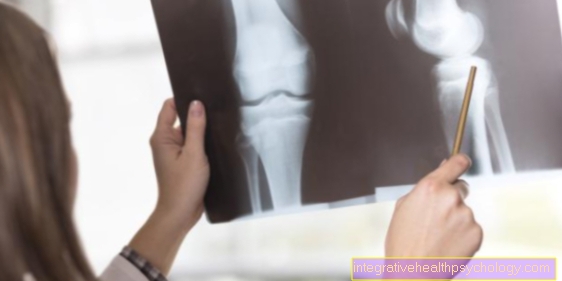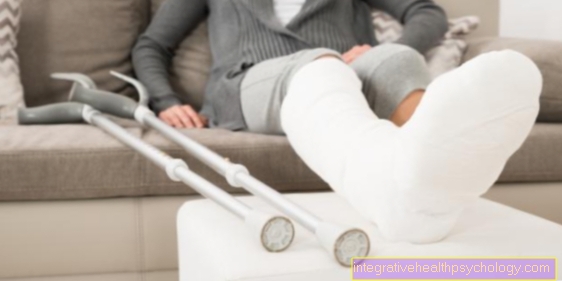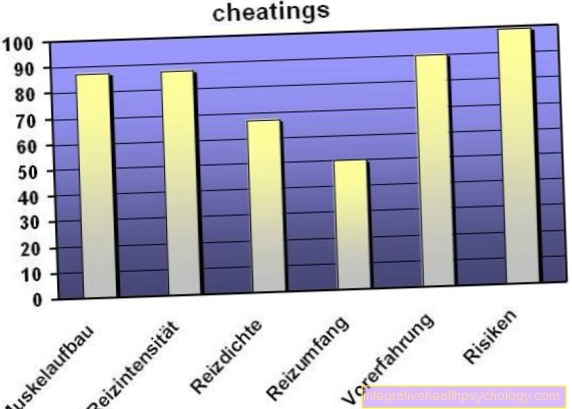Pain after knee replacement surgery
definition
TEP is the abbreviation for total endoprosthesis and describes a complete joint replacement.
In the case of the knee, this means that both the joint surface of the thigh bone and the joint surface of the tibia, which, among other things, form the knee joint, are replaced by a prosthesis. A knee replacement surgery is carried out if the symptoms of damage to the knee joint from osteoarthritis cannot be contained with non-surgical therapy and the quality of life of the person affected is severely limited as a result.
Temporary pain after the operation is normal, but can be triggered by various causes if it continues for a longer period of time.

Causes of pain
The pain after a knee replacement surgery can have various causes.
It is normal for pain to persist for a period of time after surgery. In most cases, these can then be treated with adequate pain therapy and physiotherapy. However, if the pain persists, there may be other underlying causes.
For example, surrounding structures such as nerves or tendons damaged during the operation can cause the pain. If the pain is not felt in the affected knee joint but in the leg, it can also be a vascular occlusion, i.e. a thrombosis. Since the bone also has to be adjusted when attaching the prosthesis, accidental bone fractures (thigh or lower leg bones) can occur that are not noticeable during the operation. Older patients with bone loss (osteoporosis) in particular can suffer bone fractures around the prosthesis even after the prosthesis has been inserted. This usually occurs when the knee is heavily strained, such as when stumbling or falling.
In addition, misalignment, incorrect positioning, instability or loosening of the new joint could cause pain after the operation. A bacterial infection of the new joint and the surrounding structures should also be detected and treated at an early stage. Stressing the new knee joint too early and too much after the operation can also lead to pain.
Read more on the topic:
- Pain with a prosthetic knee
- Signs of thrombosis
Concomitant symptoms
Pain and swelling after knee surgery are not uncommon and can occur even if the disease progresses normally.
Suddenly new swelling, redness or warming of the knee joint should be seen as warning signs. Caution is also required if wound secretion suddenly emerges in the area of the operation. If you have a fever, you should definitely get an examination as it can be a serious inflammation. In the course of the inflammation, flu-like symptoms such as chills, fatigue, headache and muscle pain can also occur.
If dull pain, swelling and a livid blue coloration of the leg occur, there may be a vascular occlusion in the leg (thrombosis). This complication usually occurs shortly after the operation, when the leg has been immobilized and adequate preventive measures, such as blood-thinning medication, have not been taken. Restriction of movement of the knee joint can also occur. This can be caused on the one hand by severe swelling, on the other hand by a misalignment or loosening of the joint.
Appointment with a knee specialist?
I would be happy to advise you!
Who am I?
My name is I am a specialist in orthopedics and the founder of .
Various television programs and print media report regularly about my work. On HR television you can see me every 6 weeks live on "Hallo Hessen".
But now enough is indicated ;-)
The knee joint is one of the joints with the greatest stress.
Therefore, the treatment of the knee joint (e.g. meniscus tear, cartilage damage, cruciate ligament damage, runner's knee, etc.) requires a lot of experience.
I treat a wide variety of knee diseases in a conservative way.
The aim of any treatment is treatment without surgery.
Which therapy achieves the best results in the long term can only be determined after looking at all of the information (Examination, X-ray, ultrasound, MRI, etc.) be assessed.
You can find me in:
- - your orthopedic surgeon
14
Directly to the online appointment arrangement
Unfortunately, it is currently only possible to make an appointment with private health insurers. I hope for your understanding!
Further information about myself can be found at
diagnosis
To find out the cause of the pain in the knee, the knee joint is examined. During inspection, for example, misalignment, redness and swelling can be noticed. In addition, the passive range of motion of the knee is examined during an examination, which can also be restricted if the knee prosthesis is disturbed. An x-ray, CT scan, and scintigraphy can show the joint and possible looseness. A blood test should also be done, which may indicate inflammation. Furthermore, if an infection of the joint is suspected, the inflammatory infiltrate should be punctured. The punctate obtained can then be examined for bacteria.
therapy
Treatment depends on the cause of the discomfort. Pain that occurs immediately after the operation is treated with pain relievers. This should make those affected pain-free so that they can perform light exercises. Pain therapy can be done with so-called NSAIDs such as ibuprofen, diclofenac or naproxen.
If the pain is severe, opioids such as fentanyl or morphine can be used. After the hospital stay, however, the pain should be largely gone. If these persist, prolonged therapy with medication can be used. For healing, it is also important to follow a follow-up treatment plan with physiotherapy and rehabilitation training after knee surgery and to adhere to it consistently. On the one hand, this avoids overloading and, on the other hand, determines training that is tailored to the new joint and the patient.
If the new knee joint is misaligned or loosened, painkillers can only help to a limited extent, as they do not eliminate the cause. Therefore, in these cases, the prosthesis must be exchanged and a new operation must be performed. If there is an infection in the knee joint, the aim of therapy is to eliminate the bacterium that is causing the inflammation. Antibiotic therapy is important here. In addition, the joint should be cooled and protected. If there is a serious infection, the joint must be removed. If a vascular occlusion is the cause of the pain, a therapy with blood thinners must be carried out, which makes the vessel open again.
You might also be interested in this topic: Rehabilitation after a knee prosthesis
How long does the pain last?
The duration of the discomfort depends on the underlying cause. Usually the pain subsides after a week after the operation with pain medication and can easily persist for a few more weeks. However, if the pain persists, a doctor should be consulted. In addition, full knee loading is usually only possible after about six weeks. Physiotherapy should be given as directed for two months after the operation and performed independently by the patient for another year.
In some cases, the pain symptoms can drag on for a longer period of time or even persist permanently. If the artificial joint is infected, it can also take several weeks to even months for the symptoms to go away. If the joint has to be removed due to the inflammation, a prolonged course must also be expected, as the inflammation must first have completely disappeared from the body before a new joint can be inserted.
If the prosthesis has loosened, a new prosthesis is inserted as soon as possible. The postoperative course after the replacement of the prosthesis should be like a course after the first use of the prosthesis - i.e. a few weeks. Broken bones usually take six weeks to heal. If a vascular occlusion has occurred as a result of the operation, this can be eliminated after a few days with rapid, drug therapy. However, drug follow-up treatment of the vascular occlusion usually takes three to six months.
Pain especially in the hollow of the knee
On the one hand, shortening of the muscles and tendons around the knee joint can lead to pain in the hollow of the knee. These shortenings can be caused by relieving the leg after the operation and can be compensated for by stretching and stretching exercises. In order to prevent these symptoms, a physiotherapy plan should be followed after the operation.
Second, a Baker's cyst can cause pain in the hollow of the knee. This leads to a bulging of the knee joint capsule due to the accumulation of inflammatory fluid, which can also be responsible for swelling of the knee joint after the operation. There is swelling. There is also pain in the hollow of the knee. The Baker cyst can be visualized by an ultrasound. A vascular occlusion can also be responsible for pain in the hollow of the knee. This can also be excluded or determined by means of ultrasound.
Read more on the topic: Baker's cyst
Pain especially in the kneecap
After the operation there may be an effusion behind the kneecap. This effusion can then cause severe pain.
Anti-inflammatory pain medication can be taken against inflammation and effusion. If the kneecap (patella) is not replaced in the course of the operation, pain may persist due to osteoarthritis of the kneecap that has not been resolved. If damage to the posterior surface of the kneecap is the cause of the pain, the kneecap can also be replaced during a new operation.
More on this: Knee joint effusion
What can you do about chronic pain after knee replacement surgery?
In order to counteract chronic pain after a knee replacement surgery, the medication plan and physiotherapy as well as rules of conduct should be strictly adhered to. If the pain persists, taking pain relievers is the therapy of choice to relieve the pain.
At the beginning, mild pain relievers belonging to the group of NSAIDs (non-steroidal anti-inflammatory drugs) such as ibuprofen, diclofenac, naproxen are chosen. If these do not have the desired effect (if the pain is more severe), they can be combined with opioids. The implementation of physiotherapy and physiotherapy is also part of pain therapy.
Osteopathic treatments can relieve muscle stiffness that may also be responsible for the pain. Acupuncture has also been shown to provide relief from knee pain. Since chronic pain can be very stressful for the psyche, psychological support should be considered at an early stage, for example to prevent or treat depression at an early stage.
You might also be interested in this topic: Chronic pain syndrome
Which pain indicates a loosening of the knee TEP?
The person concerned usually only notices the loosening when it is too late and the implant is moving in the bone.
This usually leads to pain, which mainly occurs when the knee is put under pressure. These can - depending on how loosely the prosthesis fit - only be felt during sport, i.e. greater loads, or even while walking.
How severe is the pain after the operation?
Immediately after the operation, there is usually no pain due to the anesthesia performed during the operation. The pain is usually most severe in the first two to three days after the operation and should subside within a week. As a rule, slight pain can be felt in the knee for two to three weeks after the operation. If the pain is not limited to the knee, other underlying causes, such as vascular occlusion, should be ruled out.
This article might also interest you: Prosthetic knee and sports
Pain after knee replacement surgery
The pain after changing a knee replacement should develop in a similar way to the pain that occurred after the first knee replacement.
So the pain should be gone after a few weeks even after the knee replacement surgery.


